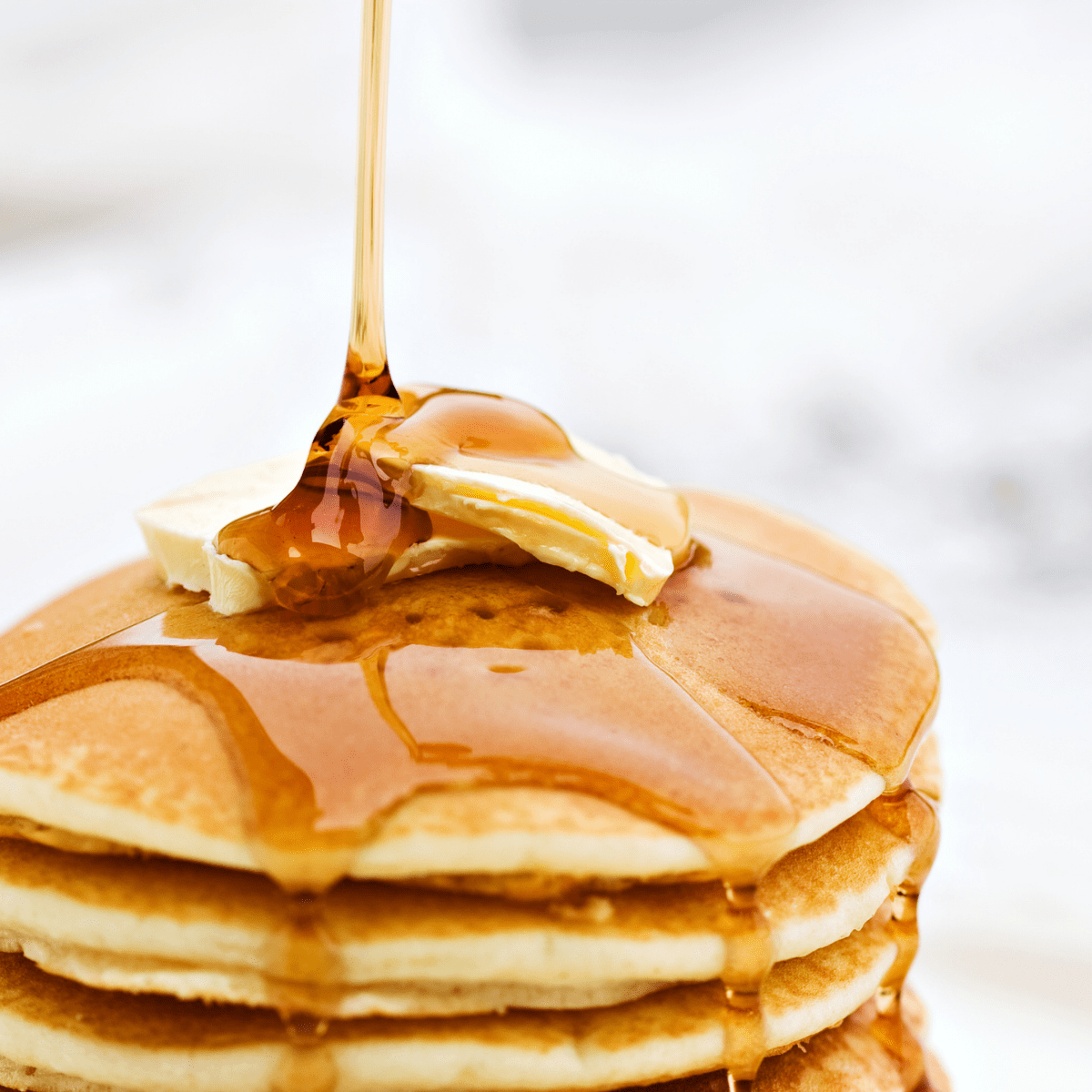Have you ever been in the middle of a recipe only to realize you were out of agave syrup? Same. Save yourself a trip to the grocery store with one of these agave syrup substitutes. Bonus: they may even be better for your health.

Jump to:
1. Honey
Honey can be used in place of agave nectar in a 1:1 ratio. So, for every 1 tablespoon of agave, substitute in 1 tablespoon of honey.
Many people wonder, can I substitute honey for agave?
Yes. Honey has a slightly thicker texture, but it still makes a good substitute for agave syrup in baking, desserts, sauces and marinades.
It does have a stronger flavour profile than agave. So, you’ll need to decide whether your recipe can work with honey flavour notes.
Like agave, raw honey is as a natural sweetener. That means it provides nutritional advantages and health benefits that refined sweeteners do not.
Honey, in particular, is rich in anti-oxidants, B vitamins, beneficial enzymes, amino acids and immune-boosting properties. That's exactly why you've been offered honey in your tea when you're sick!
One thing to note is that honey loses some of its nutritional benefits when heated. So, if you're using honey for the health advantages, it's best to use it as a topping.

2. Molasses
Molasses can be used in place of agave nectar in a 1:1 ratio. So, for every 1 tablespoon of agave, substitute in 1 tablespoon of molasses.
Molasses is a good sub for agave syrup. It's a thick liquid with a sweet, warm flavour that's similar to maple syrup and stronger than agave.
Molasses is a natural sweetener. That means it's free of added sugars and provides some nutritional benefits. It also means that our blood sugar spikes less rapidly after consumption.
Molasses is a good source of iron, selenium, and copper, all of which help us maintain healthy bones.

3. Coconut nectar
Coconut nectar can be used in place of agave syrup in a 1:1 ratio. So, for every 1 tablespoon of agave nectar, substitute in 1 tablespoon of coconut nectar.
Coconut nectar is the syrup derived from the flowers of the coconut palm. Coconut nectar makes a good sub for agave nectar because it has a syrup consistency.
Its flavour profile is rich in caramel notes, and a little less sweet than agave. It's an ideal swap for agave in baking and desserts.
Like most of my recommendations, this is another natural sweetener. It's free from chemical processing and has a low glycemic index score compared to most other sweeteners.

4. Brown rice syrup
Brown rice syrup can be used in place of agave syrup in a 2:1 ratio. So, for every ½ cup of agave syrup, substitute 1 cup of brown rice syrup.
Brown rice syrup (also known as maltose syrup) is a liquid sweetener that works well as an agave syrup replacement in baking and in condiments. Its sticky texture also makes it ideal for recipes that need a binding agent, like homemade granola.
Its flavour profile is significantly less sweet than agave syrup. Instead, it has a nutty flavour that is reminiscent of butterscotch. So, increase the amount of brown rice syrup used to taste.
Brown rice syrup has a slightly higher GI index score than agave syrup, but it is still a natural sweetener that is both fructose and gluten free.

5. Maple syrup
Maple syrup can be used in place of agave nectar at a 1:1 ratio. So, for every 1 tablespoon of agave syrup, substitute 1 tablespoon of maple syrup.
Maple syrup is another suitable sub for agave nectar. Because its texture is similar, it can be swapped easily for baking, cooking and drizzling.
However, if you have a sweet tooth, you may want to add a little extra maple syrup because it isn't as sweet as agave.
Maple syrup comes directly from the sap of a maple tree. Because of this, it offers up some powerful health benefits. It's high in antioxidants and important micronutrients like riboflavin, zinc, magnesium, calcium and potassium.
Just be sure to read the label to make sure you're buying 100% pure maple syrup rather than pancake syrup that's filled with all sorts of artificial chemicals.

6. Liquid stevia
Liquid stevia can be used in place of agave syrup at a 1:1 ratio. So, for every 1 tablespoon of agave syrup, substitute 1 tablespoon of liquid stevia.
Liquid stevia is another agave syrup alternative. It is 300 times more sweet than table sugar. That said, it has a slightly liquorice aftertaste, so it's better to use in bold flavoured recipes that can mask this.
Because liquid stevia is sold as drops, it's useful when needed in smaller quantities like in drink and cocktail recipes.
Stevia is a natural sweetener made from the leaves of the stevia rebaudiana plant. It is both carb and calorie free, so can be a good option if you're trying to manage your weight.

7. Date syrup
Date syrup can be used in place of agave syrup at a 1:1 ratio. So, for every 1 tablespoon of agave nectar, substitute 1 tablespoon of date syrup.
The most natural sweetener you can opt for is fruit. So, if you're only looking for a healthy agave syrup alternative, the use of dates may just be the perfect option. They'll be sure to boost your fibre and antioxidant intake too.
If you want a syrup like consistency that's closer to maple syrup, you'll need to reduce your dates using my recipe below. Alternatively, you can buy this syrup in middle eastern stores.

Date syrup recipe
- Cook Time: 2 hours
- Total Time: 2 hours
- Yield: 1 cup 1x
- Category: Condiments
- Method: Stove
- Cuisine: American
Description
Have you ever been in the middle of a recipe only to realize you were out of the sweetener you needed? Same. Save yourself a trip to the grocery store with this healthy date syrup swap.
Ingredients
- 0.5 lb Medjool dates
- 2 cups of water
Instructions
- Chop and remove the pit from the dates.
- Add dates to sauce pan and cover with water. Bring to a boil, then reduce to simmer for one hour.
- Remove from heat and cool for 30 minutes.
- Transfer the mixture to a blender and blend for one minute, or until smooth.
- Pour the mixture through a nut milk bag or a fine mesh strainer lined with cheese cloth. Press out as much date syrup as possible.
- Add back to stove top and cook on medium heat for 30-45 minutes to reduce further. Be careful not to burn during this stage.
- Cool and transfer to airtight container in fridge for up to three weeks.
Notes
- It's easier to chop the dates using kitchen shears
Keywords: healthy condiments, easy recipes
What is agave syrup?
- Agave syrup, also known as agave nectar, come from the agave plant
- Agave syrup can be purchased in light, medium or dark grades. The flavours intensifies as the colour darkens.
- Its flavour is more neutral than maple syrup or honey, and has a flowery after taste
- It has been used both for cooking and medicinally for centuries in South America
- It has a low GI score, making it useful for those trying to manage their blood sugar
Agave nectar vs agave syrup
Agave syrup and agave nectar are used interchangeably.
However, agave nectar technically refers to the sap extracted from the agave plant. Agave syrup on the other hand, refers to the product found on grocery store shelves. It is processed using heat, which destroys any beneficial health effects found in the nectar.
Is agave syrup healthy?
The agave syrup found on your grocery store shelves is not the same agave nectar used for centuries in South America. It is treated with heat and enzymes, resulting in a highly refined and unhealthy end product.
It does have a low GI score, which can be helpful to diabetics or others trying to manage their blood sugar levels.
That said, it is higher in calories than table sugar and is extremely high in fructose. Since our liver is the only organ that can metabolize fructose in high amounts, excess consumption of agave syrup can be hard on our livers and even lead to insulin sensitivity in the long run.
Because of this, I think it's a safer bet to use other natural sweeteners like the ones listed in this article.
How to use agave syrup
Here are some of my favourite recipes that use agave nectar or an agave syrup alternative:
I want to hear from you!
Have you tried any of these subs for agave syrup? Do you have any of your own?Please take a minute to leave a comment below.








Leave a comment!